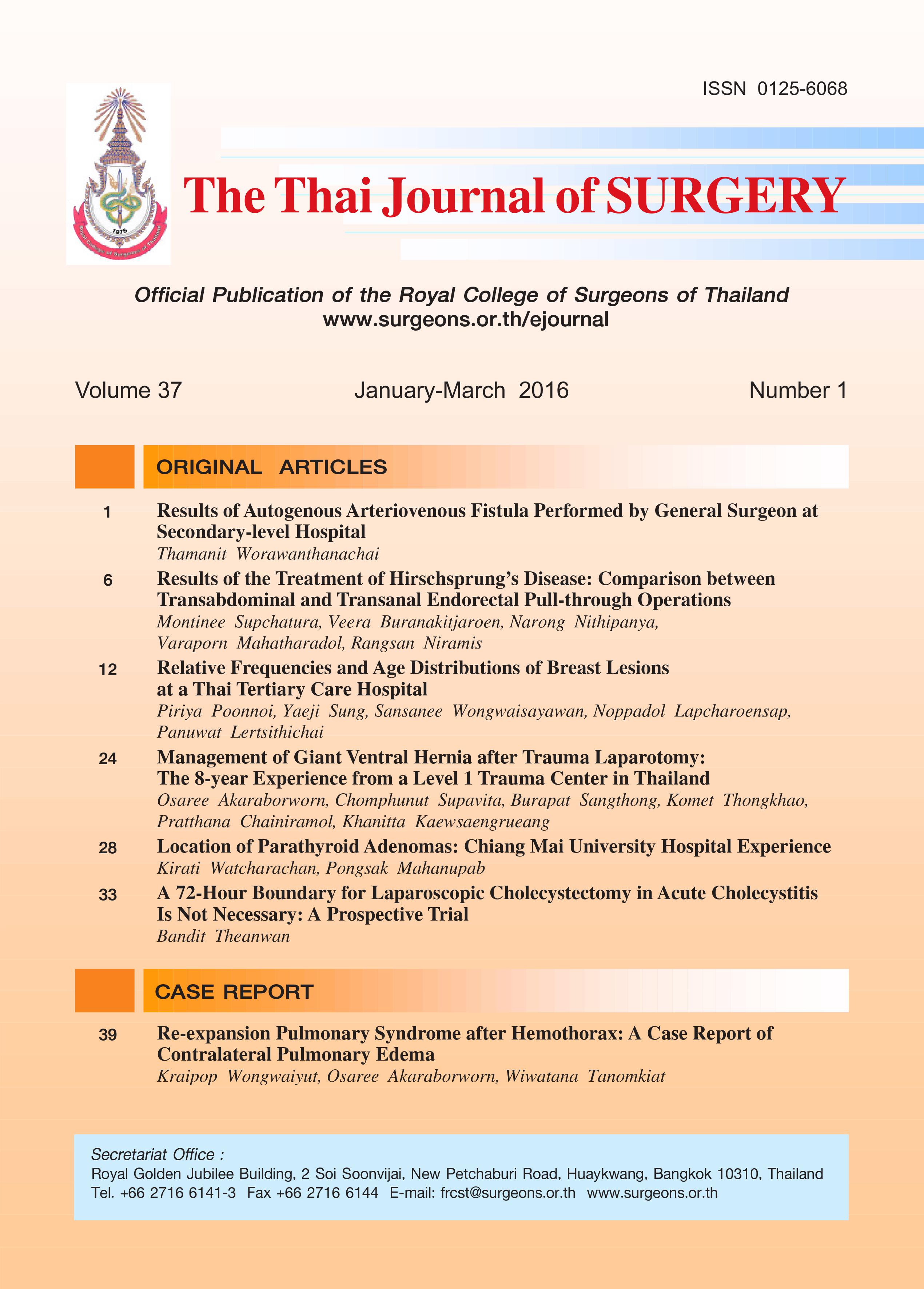Results of Autogenous Arteriovenous Fistula Performed by General Surgeon at Secondary-level Hospital
Keywords:
Autogenous arteriovenous fistula, maturation rate, primary patency rate, complication rate, ESRD, general surgeon, secondary-level hospitalAbstract
Background and Objective: To determine the results of autogenous arteriovenous fistula (AVF) performed by a general surgeon at secondary-level hospital, in terms of maturation rate, primary patency rate, and complication rate.
Material and Methods: Between October 2011 and November 2014, 64 patients with indications for hemodialysis (HD) were considered for permanent venous access at Phetchabun Hospital. Fifty AVFs were performed on 47 patients who had been selected on physical examination to have adequate vessels. Patients were followed until June 2015. Results: Of 64 patients, 47 patients (73%) underwent 50 AVFs which composed of 3 radiocephalic AVF (6%), 46 brachiocephalic AVF (92%) and 1 brachiobasilic AVF (2%). Overall maturation rate was 90%. Mean time of maturation was 8.6 weeks. Primary patency rate was analyzed by descriptive survival analysis. Primary patency rate of AVF at 6th month, 1st, 2nd and 3rd year was 89%, 87%, 82% and 82%, respectively. Post-operative hematoma was the only complication seen (8%).
Conclusion: General surgeons in the setting of secondary-level hospital can perform AVF effectively in selected patients, selecting appropriate types of AVF, with proper time of initiation hemodialysis.
References
2. Coresh J, Selvin E, Stevens LA, et al. Prevalence of chronic kidney disease in the United States. JAMA 2007;298:2038-2047.
3. KDIGO 2012. Clinical practice guideline for the evaluation and management of chronic kidney disease. Kidney Int Suppl. 2013;3:5.
4. Chayakul C, ed. Hemodialysis clinical practice recommendation 2014.1st ed. Bangkok:Duantula publisher; 2014.
5. Gibson KD, Gillen DL, Caps MT, Kohler TR, Sherrard DJ, Stechman-Breen CO. Vascular access survival and incidence of revisions: a comparison of prosthetic grafts, simple autogenousfistulas, and venous transpositionfistulas from the United States Renal Data System Dialysis Morbidity and Mortality Study. J Vasc Surg 2001;34:694-700.
6. Kheriakian GM, Roedersheimer LR, Arbaugh JJ, et al. Comparison of autogenousfistula versus expanded polytetrafluoro-ethylene graft fistula for angioaccess in hemodialysis. Am J Surg 1986;152:238-43.
7. Lee H, Manns B, Taub K, et al. Cost analysis of ongoing care of patients with end-stage renal disease: the impact of dialysis modality and dialysis access. Am J Kidney Dis 2002; 40:611-22.
8. Rayner HC, Pisoni RL, Gillespie BM, et al. Creation, cannulation and survival of arterio - venous fistulae - data from the Dialysis Outcomes and Practice Patterns Study (DOPPS). Kidney Int 2003;63:323-30.
9. Thomson P, Stirling C, Traynor J, et al. A prospective observational study of catheter - related bacteraemia and thrombosis in a haemodialysis cohort: univariate and multivariate analyses of risk associations. Nephrol Dial Transplant 2010;25:1596-60.
10. Mendes RR, Farber MA, Marston WA, et al. Prediction of wrist arteriovenous fistula maturationwith preoperative vein mapping with ultrasonography. J Vasc Surg2002;36:460-3.
11. The Vascular Access Work Group. NKF-DOQI clinical practice guide-lines for vascular access. National Kidney Foundation-Dialysis Out-comes Quality Initiative. Am J Kidney Dis 1997;30(suppl 3):S150-91.
12. Sidawy AN, Gray R, Besarab A, et al.Recommended standards for reports dealing with arteriovenous hemodialysis accesses. J Vasc Surg 2002;35:603-10.
13. Silva MB Jr, Hobson RW II, Pappas PJ, et al. A strategy for increasing the use of autogenous hemodialysis access procedures: impact of perioperative noninvasive evaluation. J Vasc Surg 1998;27:302-7.
14. Huber TS, Ozaki K, Flynn TC, et al. Prospective validation of an algorithm to maximize native arteriovenousfistulae for chronic hemodialysis access. J Vasc Surg 2002;36:452-9.
15. Hakaim AG, Nalbandian M, Scott T. Superior maturation and patency of primary brachiocephalic and transposed basilic vein arteriovenous fistulae in patients with diabetes. J Vasc Surg 1998;27:154-7.
16. Sheela T, John H, Joseph L. Failure of arteriovenous fistula maturation: an unintended consequence of exceeding dialysis outcome quality initiative guidelines for hemodialysis access. Journal of vascular surgery 2003;38:439-45.
17. Huber TS, Carter JW, Carter RL, Seeger JM. Patency of autogenous and polytetrafluoroethylene upper extremity arteriovenous hemodialysis access: a systematic review. J Vasc Surg 2003;38:1005-11.
18. Fisher CM, Neale ML. Outcome of surgery for vascular access in patients commencing hemodialysis. Eur J Vas Endovasc Sur 2003;25:342-9.
19. Wongkonkitsin N, Prasertcharoensuk S. Patency of vascular accesses for thai hemodialysis patients. J Med Assoc Thai 2014;97:317-21.
20. NKF K/DOQI. Clinical practice guidelines and clinical practice recommendations for vascular access: 2006 updates: hemodialysis adequacy, peritoneal dialysis adequacy and vascular access.Am J Kidney Dis 2006; 48 (Suppl 1): S1-322.
21. Ortega T, Ortega F, Diaz-Corte C, et al. The timely construction of arteriovenous fistulae: a key to reducing morbidity and mortality and to improving cost management. Nephrol Dial Transplant 2005;20:598-603.
Downloads
Published
How to Cite
Issue
Section
License
Articles must be contributed solely to The Thai Journal of Surgery and when published become the property of the Royal College of Surgeons of Thailand. The Royal College of Surgeons of Thailand reserves copyright on all published materials and such materials may not be reproduced in any form without the written permission.



